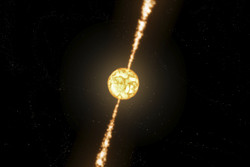Studying the end points of stellar evolution
Strong gravity and extreme magnetic fields turn neutron stars and black holes into unrivalled test beds of particle physics, general relativity and magneto-hydrodynamic phenomena. The EU-funded project ACCRETION STATES (Multiwavelength spectral timing of black holes and neutron stars: A new step in our understanding of accretion processes) focused on a process that powers these astrophysical sources: accretion. Accreting neutron stars and black holes are among the brightest sources in the X-ray sky. X-ray observations of neutron stars allowed astrophysicists to look into the behaviour of matter under the most extreme conditions of density and magnetic field strength. However, accreting black holes were the only astrophysical places where they could study phenomena occurring within a few gravitational radii from their source. The study of ACCRETION STATES scientists was based on observations of more than 10 black holes and 50 neutron stars. This is the largest available sample of observations that is expected to provide a reference point for classifying their behaviour into distinct accretion 'states'. Distinguished by different spectral and temporal properties, these states reflect the geometry and radiative efficiency of accretion flows. During the so-called hard state, observed in the initial rise of accretion, the X-ray spectrum is dominated by Compton emission and shows high variability. It precedes a soft state of roughly constant luminosity. As thermal accretion dominates, the luminosity of the source slowly decays until a reverse transition to the hard state occurs. This behaviour, known as hysteresis, was found to be common among both neutron star systems and systems harbouring black holes. These findings have been described in numerous publications in peer-reviewed journals and presented at international scientific conferences. The ACCRETION STATES project has advanced our empirical understanding of changes in the X-ray spectra of the end points of stellar evolution as well as some of the underlying theories for this origin.
Keywords
Stellar evolution, neutron stars, black holes, accretion, X-ray observations

